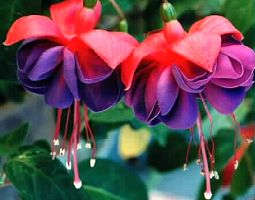May
2002
Did you know that
the plant Fuchsia took it's name in the honor of Leonard Fuchs, a
German botanist who had never seen any Fuchsia in his life?
 |
|
Fuchsia
|
- Fuchsia
Most species of Fuchsia come from South
America, from Mexico to Magallanes' Strait. A few species have been also found in New Zealand and
Tahiti,
probably having traveled there in remote times in the Planet's History.
The first mentions about fuchsias, although not with their later name, come from the XVI
Century. It was said then that the Incas, in Peru, were growing certain bushes (F.
Boliviana) because of their
edible berries.
The garden fuchsia was an
instant hit when it was introduced into European gardens, but it was
slow to arrive because of the political intrigues of a bygone era. When
fuchsia was finally introduced into
cultivation during the late 1700's it quickly rose to superstar status
and became the most popular flower of the Victorian era – the high
water mark of gardening.
Fuchsia naturally occurs in territory that
Spain claimed as its own. That nation was trying to hold on to vast
stretches of the New World with only limited resources. France had
been shut out of the Caribbean, but in the late 17th
Century, Louis XIV hit upon a scheme to establish a beachhead by
coming to the aid of Spain against England in exchange for a piece of
the island of Hispaniola. Today, that territory is Haiti.
Michel Begon, after whom the begonia is
named,
was sent as governor along with Father Charles Plumier, to minister to
the religious needs of the inhabitants. Plumier was sent to the
American continent seeking medicinal plants, specially the tree from
which quinine is extracted in order to treat malaria, which was a
problem in Europe in those times. Both were interested in
natural history and described the new plants of the island. Plumier
én 1696 found, in Santo Domingo, a new plant that the natives called "The
Beauty Plant". It was a bush with pendant flowers that had red sepals and blue
petals.
Plumier published a description of the plants in 1703 and named the
new plant "Fuchsia" in the honour of Leonhard Fuchs (1501 - 1566), a German physician and
botanist. Plumier was an admirer of Fuchs works on methodology for
classification of plants. By the way, Fuchs never could
have seen any Fuchsia in his life. Plumier, ironically, died of malaria when he was getting ready to
begin his fourth journey to America.
Fuchsias remained forgotten in Europe until 1773, when William Hogg
sent some seeds of F. triphylla to Kew Gardens, in London. The Kew
Gardens, since centuries, are playing a fundamental role in vegetal
research. The first plant to reach Europe alive did so
of the breakdown of an English sailing ship returning from China in
1788. The ship, under the command of a Captain Firth, had to pull into Chile for
repairs before attempting the stormy Strait of Magellan passage. While
making the repairs, Firth walked the shore and happened upon a
beautiful exotic he thought his mother might like, so he dug it up and
took it home to her perched on the window of his cabin. It flourished
and a nurseryman of Kew
Gardens soon saw its potential and quickly introduced it to
the trade of the plant-hungry European market. This led to a stampede
to find new kinds of fuchsias and over the next century almost 100
species were found, mostly in the territory that Spain was trying to
keep closed.
Presently there are more than 12,000 registered
species, hybrids an
cultivars and there
is interest for fuchsias in many countries.
Source:
http://www.arhomeandgarden.org/plantoftheweek/articles/Fuchsia.asp
http://www.docum.com/jardin/
|
